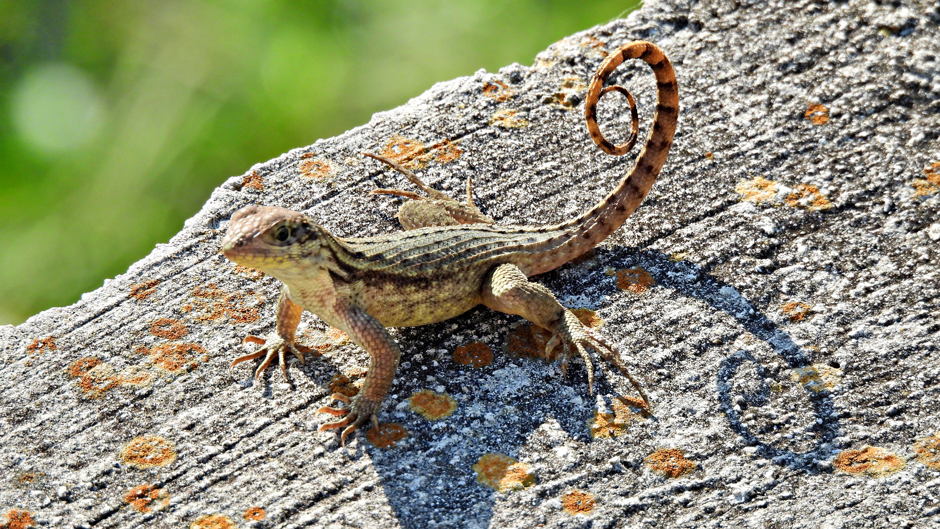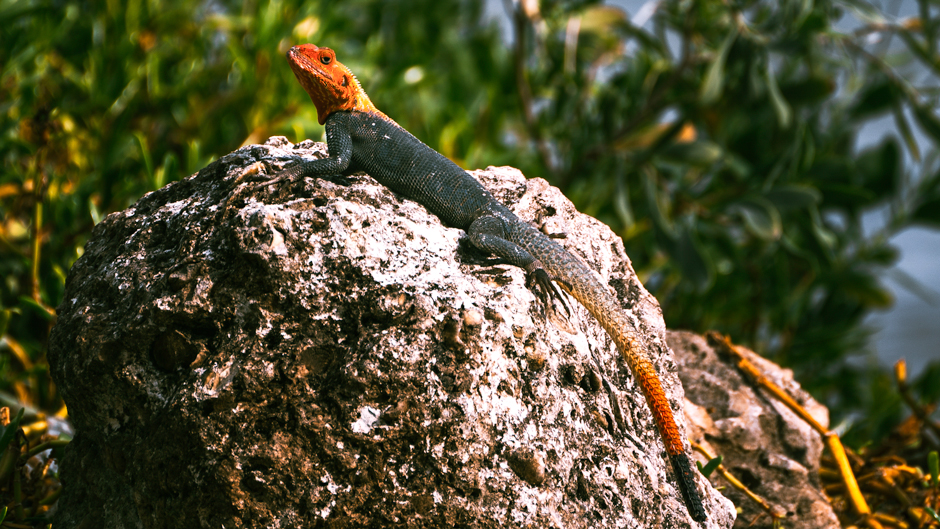Have you spotted a rainbow-colored lizard in your South Florida backyard recently? What about a curly-tailed reptile dashing across the road?
If you answered “yes,” you are not the only one seeing more of these new additions to the local landscape.
Florida is home to the world’s most diverse population of non-native reptiles and amphibians, making it a remarkable hub for these species. Rainbow lizards, formally known as the Peter’s Rock Agama (Agama picticauda), and curly-tailed lizards have seen unprecedented rates of growth in South Florida, according to Christopher Searcy, an associate professor of biology at the University of Miami College of Arts and Sciences.
“Over the past five years, they have really taken off and [the agamas] are now the fastest spreading reptile species in Miami-Dade,” he said.
Searcy, whose research focuses on reptiles and amphibians and has been studying the shifting community of non-native reptiles and amphibians in Miami, answers questions about these two species of lizards, where they came from, and their role in the South Florida ecosystem.
We’re seeing new lizard species around South Florida. They seem larger, more colorful, and more prevalent than other lizards. What can you tell us about the rainbow-colored lizard?
Originally identified as the African rainbow lizard (Agama agama) in 2004, subsequent work has shown that the South Florida population is actually Peter’s Rock Agama (Agama picticauda). They are from West Africa. They were first introduced near Miami International Airport in the 1970s, but that population was almost certainly extirpated by a construction project at their introduction site. The current population is probably from a second introduction in Homestead in the 1990s. When I started my position at UM in 2016, there were a handful of sites where one could reliably find this species. This included limestone walls at Matheson Hammock Park and (appropriately) the African spiny forest at Fairchild Tropical Garden. Over the past five years, they have really taken off and are now the fastest spreading reptile species in Miami-Dade. My lab has been studying the shifting community of non-native reptiles and amphibians in Miami, and we estimate that agamas increased 36-fold between 2017 and 2022.
How do these rainbow lizards differ from the ones already found in Florida?
It is important to note that Florida has the most diverse community of non-native reptiles and amphibians anywhere in the world. We have 58 established species—most of them in South Florida rather than further north—which is almost twice as many as the next most diverse non-native reptile and amphibian community, which is Hawaii with 32 species. In fact, South Florida has more non-native species across all taxonomic groups than any other continental region in the world. My lab has just completed a review paper on this topic, which will be published in this year’s issue of “Annual Review of Ecology, Evolution, and Systematics.” Thus, agamas are very different from all of Florida’s native lizards—the Agamidae family is exclusively from the Old World—but there are now a number of other agamid species established in South Florida as well: the Variable Bloodsucker (not nearly as scary as it sounds—just named for the bright orange or crimson coloration around the head and shoulders of the breeding males), the butterfly lizard, and the red-banded butterfly lizard, although none of these others are nearly as widespread as Peter’s rock agama.
Where are rainbow lizards typically found, and what factors are driving their growing presence in South Florida?
As implied by their name, Peter’s rock agamas are rock specialists (the SAT word for this is saxicolous). They were originally found most often near the many limestone walls common in Miami. Now I see them everywhere as I drive around the city. I don’t think we can say for sure why this is happening, but my educated guess is that cement is close enough to rock that the agamas are quite successful in areas with lots of cement, and there is plenty of cement in Miami. My lab is working on another study comparing the spread of agamas with the spread of basilisks (also known as the Jesus Christ lizard for their ability to run across the surface of water and another member of South Florida’s diverse non-native reptile community). We have found that agamas are highly associated with urban parts of the county (i.e., areas with lots of cement), whereas the basilisks are more common near ponds, canals, and croplands.
Do rainbow lizards pose any threats to the local ecosystem or native species?
As with most of South Florida’s diverse non-native species, we don’t really know their impact on native species, because no one has studied it. There are obviously some non-native species that have had huge impacts on our native ecosystems (this is summarized in the aforementioned review paper). I’m sure the Burmese pythons that have consumed 98 percent of the small mammals in Everglades National Park leap to everyone’s mind. For the agamas, the only noted impact is that they seem to decrease the density of Miami’s most abundant non-native lizard, the brown anole. In my lab’s most recent survey, we estimated that this one species accounted for 44 percent of all reptiles and amphibians in the county. However, even this impact on brown anoles is only anecdotal and hasn’t really been studied.
What about the other type of lizards most of us have spotted—like the curly-tailed species we see running around?
This is the Northern curly-tailed lizard (Leiocephalus carinatus). This species was originally introduced in Palm Beach in the 1950s and has been slowly spreading southward. If you talk with residents of Palm Beach, they will tell you that there have been dense populations of this species for decades, but they have just started to reach our part of South Florida. My lab estimates that they increased 22-fold in Miami-Dade County between 2017 and 2022, making them the second fastest spreading non-native reptile.

How do those differ from the existing species, and even the rainbow lizard, in Florida?
This is again another non-native species, although in this case their native range is much closer to Miami, since they are from the Bahamas. While not closely related to the agamas, they share many ecological similarities. They are another species that likes open areas with rocks and that seems to be thriving in South Florida’s urbanized habitat. They are often described as gregarious, because they often let people approach pretty closely before running away. In contrast, the agamas are usually described as skittish.
Are curly-tailed lizards native to South Florida, or are they an invasive species?
They are invasive, although again their impact on native Florida fauna is not well known. It is well documented that they are major predators of brown anoles in the Bahamas, where both species are native. So, presumably, they eat them in South Florida as well. It is also suspected that they have negative effects on two of Florida’s native lizards: the Eastern six-lined racerunner and the Florida scrub lizard.
Have there been any instances of hybridization between the rainbow and curly-tailed lizards or with other species in the area?
No. Agamas and curly-tails are from different lizard families that diverged about 200 million years ago, so no chance of them hybridizing. The only important hybridization happening in South Florida lizards is between our native green anole and its close relative the Cuban green anole. At this point, most of the green anoles we see may be hybrids between the two species. This could be viewed as a bad thing, since the true native green anole may be largely gone at this point (at least in the Miami area). On the other hand, the hybrids may be more robust to competition with the many non-native anole species now found in South Florida. And so the hybridization may be important in ensuring that at least some form of green anole persists in our area.
Lastly, what advice would you give to residents who encounter and influx of rainbow or curly-tailed lizards in their yards? How should they interact with these creatures, if at all?
There is no need to be afraid of any of the diverse non-native lizards now common in South Florida. Even the largest species—the Nile monitor—will run away from people as soon as it sees them. Although I wouldn’t recommend backing one into a corner where it felt it needed to defend itself rather than running away.
There is certainly no need to be afraid of the agamas or curly-tails. The agamas won’t let you get close, and even the “friendly” curly-tails will run off before you are close enough to touch them.
It would of course be best for our native species if none of these non-natives were present, but many of them are so widespread and common at this point that removing them is not feasible. Examples of successful eradication of non-natives in South Florida are very limited, and only occurred when non-native species were confined to very small areas (e.g., non-native fish confined to single ponds) or flocked together where they could be removed (Sacred Ibis were successfully removed because they nest in colonies).
Instead, we should focus on the importance of not letting any new non-native species become established. Most of the non-native reptiles and amphibians in South Florida originated from the pet trade. So, it is very important that people understand the commitment when getting a new pet in terms of how big the animal will eventually get and how long it will live. If you do want to get rid of a pet, don’t just release it into the wild. Find a new owner or give it to the Florida Fish and Wildlife Conservation Commission during one of their amnesty days when they accept non-native pets.

